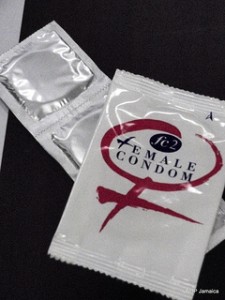Celebrating Condoms – the Female Version
Sep 11th, 2012 | By admin | Category: Family PlanningBy Suzanne York, howmany.org
It may have escaped your attention, but today, September 12th, is the first-ever Global Female Condom Day. Promoted by the National Female Condom Coalition, the purpose is to increase the number of women, men, youth and transpeople who know about, use, and advocate for female condoms.
The coalition is made up of reproductive health and justice, women’s health, youth, and gay men’s health organizations and advocates, health departments, and researchers.
A female condom is a pouch that is used during intercourse to prevent pregnancy and reduce the risk of sexually transmitted diseases. The most widely used female condom is shaped like an oversized male condom with a thin and soft texture. Read more about how it works here. Planned Parenthood states that if women always use the female condom correctly, 5 out of 100 will become pregnant each year.
Why is promoting female condoms important? Essentially because it empowers women. The female condom is the only female-initiated method available that can be worn by women for protection against both unintended pregnancy and sexually transmitted infections.
“Female condoms are the only barrier method that can be initiated by the receptive partner, which allows women and men take control of their own health,” said Carole Brite, President and CEO of Planned Parenthood of Illinois. “It is imperative that women and men are aware of all the options available to them so they can choose the method that is best for them in order to stay healthy and safe.”
The U.S. Agency for International Development (USAID) reports the number of female condoms distributed is only 1.6 percent of total global condom distribution. Cost is one factor – prices range from $2.50 to $5.00 each, which is almost five times more expensive than the male condom.
The Female Health Company, which makes the FC2 (the second generation of the female condom), says new prototypes of female condoms are being developed but are still undergoing clinical trials and regulatory approvals. The FC2 was approved by the United States Food and Drug Administration in 2009. USAID believes the female condomcould also help pave the way for future female-initiated products, such as microbicides and new multipurpose combination technologies.
Women-friendly contraceptives are wanted, and many women are looking for a single available contraceptive method that meets their needs. The Guttmacher Institute, in its latest issue of Perspectives on Sexual and Reproductive Health, wrote that “a survey of 574 women seeking abortions at six U.S. clinics—women considered to be at high risk of engaging in unprotected sex and experiencing an unintended pregnancy—found that the contraceptive methods currently available largely lack the features that are important to them.“
Guttmacher found that according to Contraceptive Features Preferred by Women at High Risk of Unintended Pregnancy, by Lauren Lessard of the University of California, Los Angeles, et al., the three features deemed most important to women surveyed were effectiveness (prioritized by 84%), lack of side effects (78%) and affordability (76%). In addition, more than two-thirds of women surveyed wanted a method that was easy to access (74%) and to use (74%), and that they had control over (70%) or were responsible for using (69%).
As for men, there apparently has been little resistance to the female condom. Mags Beksinska, a technical advisor to the Reproductive Health & HIV Research Unit at the University of the Witwatersrand in Johannesburg, who researched the efficacy of FC2 before it received FDA approval, told Newsweek that men appear to be quite happy with it. She said, “It’s because they don’t have the responsibility of using it.”
It is important that women have control over their reproductive rights, which includes access to a safe contraceptive method that works best for them. The female condom could be that method, but cost, effectiveness, and availability issues must be addressed. For now, greater awareness and education about the female condom is needed, and recognizing Global Female Condom Day is a good way to get the ball rolling.
Suzanne York is a senior writer with the Institute for Population Studies/HowMany.org

